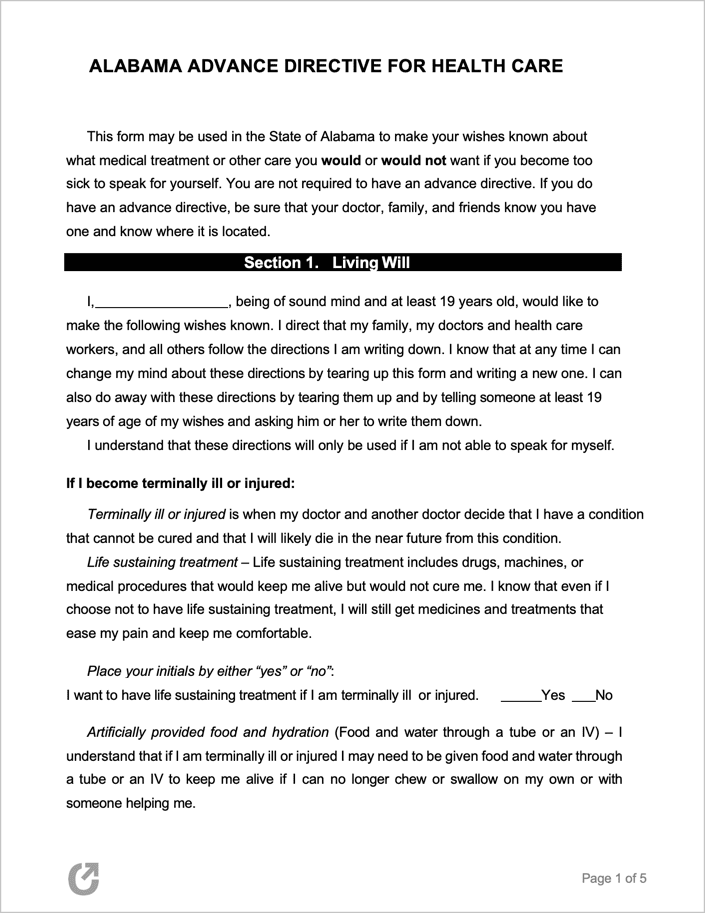Alabama Advance Directive Form
An Alabama advance directive is a two (2) part document created by a principal before experiencing health complications. The first section (the “living will”) outlines a principal’s medical preferences if they become terminally ill, injured, or permanently unconscious. The second section (the “medical power of attorney”) allows an agent to make medical choices and arrangements for a principal if they become incapacitated. While this form is not required, completing it ensures that a principal’s wishes are clear under these circumstances. The principal must store it in a safe place that the agent, family member, or friend can access.
|
What is an Alabama Advance Directive Form?
An Alabama advance directive form is a legal document that combines two essential healthcare-related components: a living will and medical power of attorney. In the living will portion, an individual, known as the principal, outlines their specific healthcare preferences and end-of-life treatment decisions. This structure ensures that medical professionals adhere to the principal’s wishes when the principal cannot communicate or make decisions.
The medical power of attorney portion allows the principal to designate a trusted individual, called an agent or healthcare proxy, to make medical decisions on their behalf. This agent steps in when the principal is incapacitated or unable to make choices for themselves. By completing an Alabama advance directive form, the principal ensures that their medical treatment preferences are respected and a trusted individual oversees their healthcare decisions when they cannot do so themselves.
How to Write
Section 1: “Living Will”
A living will allows the principal to state how they wish to be taken care of medically when they can’t make decisions for themselves.
On the first line, enter the name of the principal (person completing the advance directive). If the principal wishes to have life-sustaining treatment if they are ill/injured terminally (permanently), place their initials on the line in front of “Yes.” If not, the principal will need to put their initials in front of “No.” On the bottom of the first page, if the principal would like to be provided water/food through an IV to stay alive, place their initials on the “Yes” line, and vice versa for “No.”
The principal will need to place their initials next to “Yes” or “No,” depending on their medical procedure preferences on the second page. This section states whether they want medical procedures, like artificial food and hydration, to keep them alive if they are permanently unconscious. The principal can include any other medical wishes on the four (4) lines provided. If they have nothing to add, they will need to place their initials at the bottom of the page.
Section 2: “If I need someone to speak for me”
In this section, the principal can name a “health care proxy.” This person makes medical decisions for the principal in the event they are incapacitated. If the principal wishes to assign a health care proxy, they will need to write their initials on the second line. The principal should enter the following information about the assigned proxy(s):
- Full name(s)
- Relationship to principal
- Address(es) (city, state, and zip code)
- Day and night phone numbers
The principal must include whether or not they want their health proxy to:
- Make decisions regarding receiving food/water through an IV;
- Adhere to the directions listed on the form;
- Follow the instructions in the document and make decisions about topics not discussed; or
- Make end-of-life choices.
Section 3: “The things listed on this form are what I want”
This section ensures that the principal understands the importance of the document. The principal should review the form with the proxy, doctors, health care providers, or lawyers before signing. If the principal wants to notify other parties of their life-sustaining treatment preferences, they must list their names in the form.
Section 4: “My signature”
To make the document official, the principal will need to enter their:
- Full name
- Birthday, month, and year
- Signature
- Date of signing
Section 5: “Witnesses”
The document requires two (2) witnesses. Each witness will need to write their printed name, signature, and the date on which they wrote their signature.
Section 6: “Signature of Proxy”
The proxy (or proxies) will need to write their full name, signature, and the date of their signing. At this point, the advance directive is complete, and each party should receive a copy.
